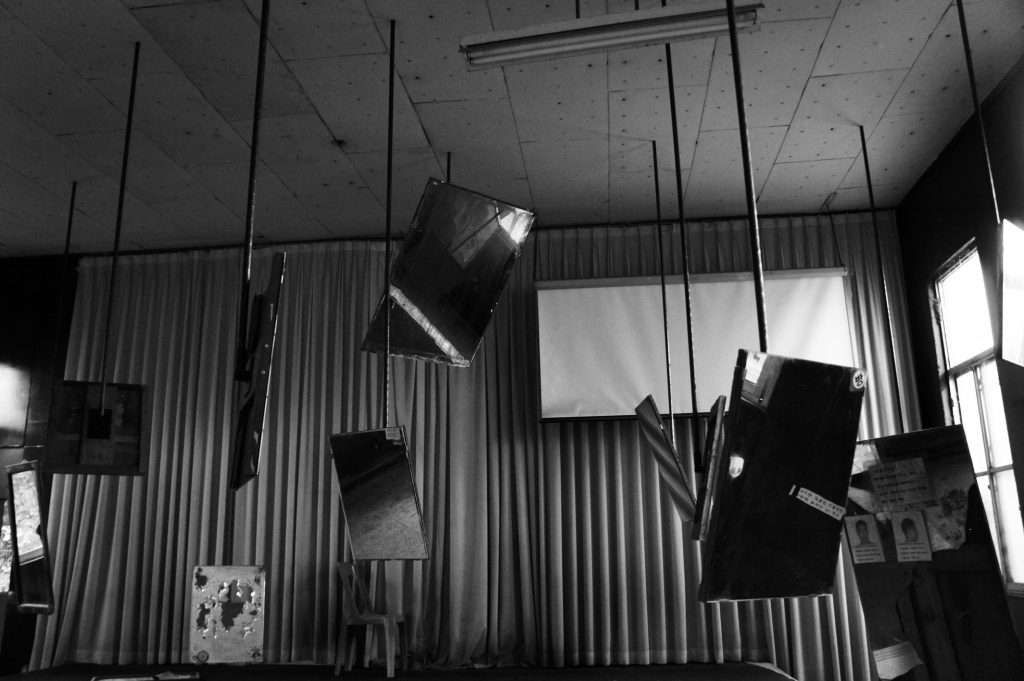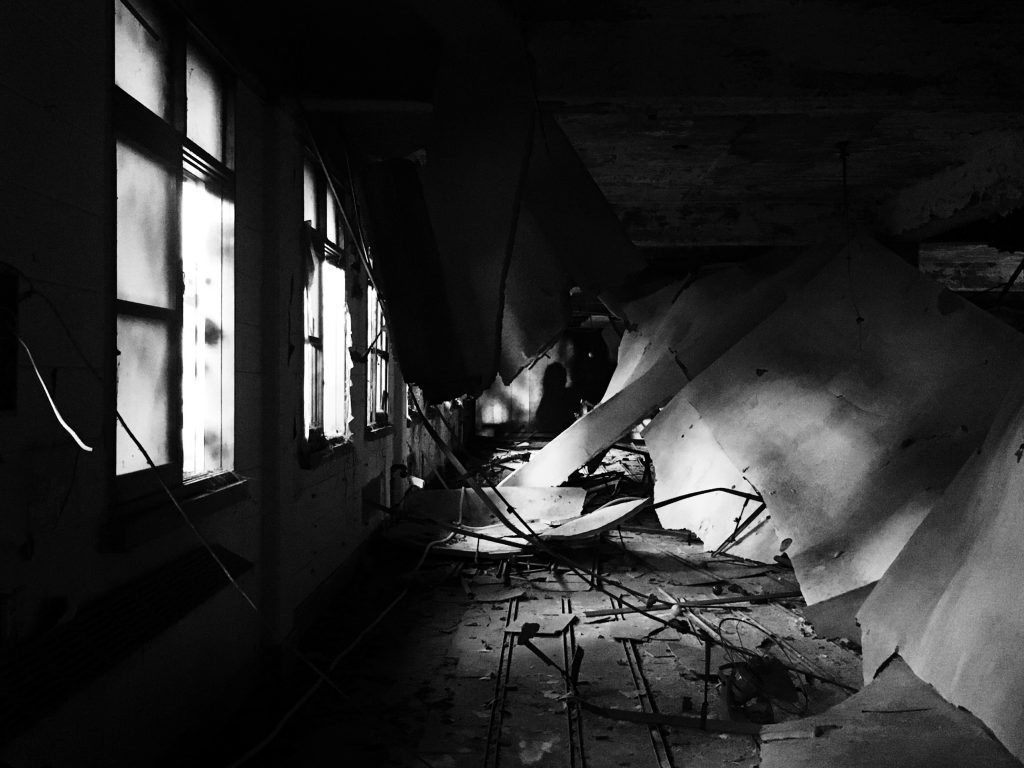Summoning the
Souls of Gwangju
12th Gwangju Biennale:
Imagined Borders – The GB Commission
Former Armed Forces Hospital,
as Art Site, Gwangju
07.09.18 – 11.11.18
Joint Second Prize
Entry in Chinese
Translated by Duncan Hewitt
As part of a new outreach programme commissioned for the 2018 Gwangju Biennale, Imagined Borders – The GB Commission, an abandoned military hospital ( the former Armed Forces Hospital ) became a satellite site of the Biennale, alongside the main exhibition venues. During the May 18 Democratic Uprising ( also known as the Gwangju Uprising ), in 1980, this place was still used as a military hospital, and citizen protesters who were victims of the military crackdown during the democracy movement were taken here for ‘treatment’. Protesters who were diagnosed as having ‘mental illnesses’ were also brought here. Since the hospital moved elsewhere and the building was closed, in 2007, it has been abandoned for more than a decade.
Today, the hospital’s white two-storey building survives, but its interior has long since been deserted and it is surrounded by wild grass and weeds. Indoors, under the dim lighting, you can see the pockmarked walls and ceiling stretching away down the long corridor towards the building’s interior, until they eventually vanish into the darkness. Rows of rooms line each side of the corridor; these used to be wards, bathrooms, toilets or cells for interrogating patients. The floor is covered in glass from the smashed windowpanes; the old window frames, the exposed water pipes and electric wires, the broken wash basins and urinals, the toilet cubicles with half-height doors, the desolate grove of trees outside the window – it’s a sight that could well remind you of a scene from the Korean horror movie Gonjiam: Haunted Asylum, which was quite popular a few years ago. When you stand here, it’s as though you can sense the patients who once lived here, as if they are still wandering through the hospital, like phantoms who refuse to go away. This place, which played such an important role in the Gwangju Uprising, has become a leftover fragment of South Korea’s democratisation movement. It’s as though the Gwangju events have left behind a scar, branded on the city.
Precisely because of its commemorative significance, the Gwangju Biennale, in its 12th incarnation last year, went back to its roots and turned its focus onto Gwangju’s history, exposing the city’s scars to the world in the name of art. The British artist Mike Nelson, the French artist Kader Attia and the Thai artist and experimental film director Apichatpong Weerasethakul accepted the Biennale’s commission, and each created a site-specific installation in this hospital.
In the chaotic political atmosphere of those days, the hospital chapel, situated at the end of a little path in the wood, provided a place of spiritual refuge for the hospital’s patients and medical staff. It has been abandoned for many years, but Nelson’s work Mirror Reverb transforms it into a three-dimensional space filled with multiple layers of reflection: mirrors of all shapes and sizes are suspended from the ceiling, reflecting from every possible angle the scene in the room, the light from outside and each visitor. Based on his research into the hospital, the artist, who is skilled at uncovering the distinctive qualities of the materials he is working with, gathered discarded items from the hospital and the chapel itself, including mirrors and the plywood boards used to support them, and reorganised them into this installation piece. These previously abandoned materials now play the role of witnesses to history: in the disused chapel building, they compose a new melody, and the vision of the past that can be seen here has been restored to its place in the temporal link between history and the present.
The impact of historical and social injustice of various kinds has formed the underlying concept of the work of Attia, a French artist of Algerian heritage. Eternal Now is his memorial for the trauma that the Republic of Korea experienced during its modern democratisation process. ‘Collective trauma is the spectre of all modernity’ – Attia attempts to ‘repair’ the scars that time brings to living things and all objects: these may be cracked teacups, floorboards split open, fractured wooden beams… The artist believes that ‘if you try to repair individual or collective trauma, you have to accept the very real chance that it may be impossible for them to heal’. In this work, Attia inserts metal staples into a series of damaged wooden beams. These tiny metal objects, which can’t be removed, are stapled onto the ‘wound’, and this process of repairing becomes a part of the wound itself, giving a new life to these injured objects.
Exposing and facing up to trauma also means facing up to the history that lies behind it. Even if it undergoes repairs, it’s also impossible to return it completely to its original state. The fractured beams and the metal staples are like two parts of a wounded body: the former point towards the time when the trauma occurred; the latter towards the post-trauma period. Now they constantly overlap, in an eternal cycle; ultimately, the wound reminds us that the past is also the present, and is particularly real.
A small white building, overgrown with vines, beside the main hospital building, was once the hospital’s leisure area, with a billiards room, a hair salon and a spacious film projection room. Today its facilities have long since fallen into disrepair. The rays of the afternoon sun shine through the trees and the dilapidated window frame onto the surviving remains. This is the setting for Weerasethakul’s video and installation work, Constellations.
Because both his parents were doctors, Weerasethakul has childhood memories of hospitals, and he is skilled at drawing these memories together and inserting them into his work. In his vision, this former military hospital is no longer a place of residence but has, rather, become a parasite, nourishing itself on the memories of the city’s residents, on the scars left on the buildings by bullets, on the flames of battle, on everything that has gone before. Over the past few years, Weerasethakul’s films have often focused on fire, shadows and dark caverns; these elements lead back to the earliest sources of moving images. He sees this hospital building as a cave, something no one else has seen before, a place of the imagination for his film works – ‘as if the fire had found its own place, and together they had constructed a cinema which exists only in the realm of dreams’.
Constellations, which combines moving images and mechanical installations, produces, by means of manipulating light and shade and objects, a range of dreamlike scenes: the billiard ball that suddenly starts rolling by itself, the screen in the projection room that automatically moves up and down, the indistinct specks of light flickering outside the window, silhouettes of people floating on the distant screen… These blend together perfectly with the surrounding environment, enveloping the viewer in its midst, creating a truly transcendental effect. Here, Weerasethakul is seeking to recreate the context, by means of capturing ‘after-images’ of Gwangju during that era. In terms of the Gwangju ‘incident’, we did not live through it ourselves, yet it feels as though we are experiencing it. The artist has transplanted his subtle treatment of memory and illusion to this hospital, transforming it into an immersive art space. This makes a complete break away from the sense of alienation, or of kitsch, which is so common in many art exhibitions or ‘white cube’ art spaces. It has allowed me to see how art can reconnect history and the present, how it can create feelings, how it can reawaken the power of the past – and then build on this power to question, challenge or guide current transformations.
召唤光州之魂金——
作为艺术场域的光州前军事医院
第十二届广州双年展:“想象的边界”
——光州双年展委任作品项目
前光州军事医院,光州
2018年9月7日-2018年11月11日
二等奖获得者
中文投稿
作为 2018 年光州双年展“想象的边界”(Imagined Borders)新增加的一项双年展委任项目(GB Commission),光州一座废弃的前军事医院(Former Armed Forces’ Gwangju Hospital)成为主场馆外另一处双年展基地。1980 年的光州“五一八民主运动”期间,这块地方曾被用作军事医院,那些在民主运动中遭受军事镇压的市民抗议者们被送往这里接受“治疗”,被认定为有“精神疾病”的抗议者也被强制押送至这所医院。自医院迁址并于 2007 年关闭此建筑以来,它已被遗弃了十年有余。
如今,医院的两层白色建筑保留了下来,但内部早已荒废,周围杂草丛生。凭借室内阴暗的光线可以看到斑驳的墙体和天花板沿着幽深的走廊向内部一直延伸, 直至消失在黑暗中。走道两侧一连串房间排列开,它们曾是病房、洗漱间、卫生间,或是审问病人的关押室。玻璃窗碎了一地,老旧的窗棂、暴露的自来水管、电线、残破的洗手池、小便池、半开门的厕所隔间、窗外荒败的小树林,这景象足以让人想起前几年颇受欢迎的韩国恐怖电影《昆池岩》中的场景。当你身处其中,仿佛可以觉察到曾经居住在这里的病人们似乎仍逗留于医院的各处,如消散不去的魅影。这个在光州事件中扮演了重要角色的地方而今已成为整个韩国民主化运动的一抹残片,它像一块光州事件遗留下的伤痕,烙印在这座城市里。
正因为其纪念碑式的意义,光州双年展在2018年第 12 届追本溯源地把目光再次聚焦光州历史,将这处伤痕借以艺术之名暴露于世人面前。英国艺术家迈克客纳尔逊(Mike Nelson)、法国艺术家卡德尔客阿蒂亚(Kader Attia)以及泰国艺术家、实验电影导演阿彼察邦客韦拉斯哈古(Apichatpong Weerasethakul)接受双年展委任,各自在这所医院创作了场域特定装置(site-specific installation)。
位于树林中一条小径尽头的医院教堂在彼时纷乱的政治氛围下为医院的病人及医护人员提供了一处精神的庇护所,在废弃多年后,纳尔逊的作品《镜面反射》(Mirror Reverb)将其改造成一个有着多重映像的三维空间。大大小小的镜子从天花板悬挂下来,它们从各个角度反射着室内的景况、室外的光线以及每一位参观者。基于对这所医院的调研,这位善于发掘材料自身属性的艺术家搜集了来自于医院及这间教堂的废旧物,包括镜子和支撑镜子的胶合板,再将它们重组为这组装置作品。这些原本被遗弃的材料扮演着历史见证者的角色,它们在如今空置的教堂建筑内谱写出一段新的乐章,其中那可见的过去的景象再次嵌入历史和当下的时间链接之中。

Mike Nelson, Mirror Reverb ( detail ), 2018, mixed media, dimensions variable. Photo: Li Suchao.迈克·纳尔逊,《镜面反射》( 局部 ), 2018,混合媒介,尺寸可变,摄影:李素超
历史与社会的种种不公带来的影响架构了阿尔及利亚裔法国艺术家阿蒂亚作品的基本概念,作品《永恒的当下》(Eternal Now)是他对韩国在现代民主化进程中所历经的创伤的祭奠。“集体创伤是一切现代性的幽灵”,阿蒂亚试图“修复”时间给生命及所有事物带来的伤痕,它们可以是有裂纹的茶杯、开裂的地板、断裂的木梁。艺术家认为,“要修复个体或集体创伤,就得接受它们很可能无法愈合的事实”。在这件作品中,阿蒂亚将金属订书钉钉在一根根破损的木梁上, 这些细小的、不可移除的金属物就这样被钉在“伤口”上,这修复的过程也成为伤口本身,赋予受伤物另一重生命。对创伤的揭露和正视即是对其历史的正视, 即使经过修复也无法完全还原最初的形态。断裂的木梁和金属订书钉就像受伤体的两个部分,前者指向创伤时期,后者则指向后创伤时期。它们在当下永恒地循环、交错,毕竟,伤口提醒着我们,过去即是现在,并且尤其真实。
医院主体建筑旁的一栋爬满枝藤的小白楼曾是医院的一处休闲场所,其中包括了桌球室、理发厅和一间开阔的放映厅,而今里面的设施早已老旧不堪,下午的阳光透过树丛和破败的窗棂照在这些残留的遗迹上,这里是阿彼察邦的影像及装置作品《Constellations》的所在地。
因其父母都是医生的缘故,阿彼察邦从小就有了对医院的记忆,他善于将这些记忆收集起来,放进他的作品之中。这座光州前军事医院在他看来不再是一处居所,而是寄生者,它以城市居民的记忆为食,以建筑物上的子弹伤痕、战火、一切逝去之物为食。过去几年里,阿彼察邦的影像常聚焦于火、影子与黑暗的洞穴, 这些元素导向了移动影像最初的源头。他将这处医院建筑比作从前不可见的洞穴, 一处他影像作品的想象之地,“好比火找到了自己的位置,它们共同筑造一间只存在于梦境中的影院”。

Apichatpong Weerasethakul, Constellations ( detail ), 2018, mixed media, dimensions variable. Photo: Li Suchao.阿彼察邦,《Constellaions》(局部),2018,混合媒介,尺寸可变,摄影:李素超。
结合了动态影像和机械装置的《Constellations》通过对光影和物件的操控,制造出各种梦寐般的场景:突然自行滚动的桌球、放映厅里自动升降的屏幕、窗外移动的模糊光斑、远处屏幕上浮现的人影……它们与周遭环境如此完美地契合,将观者牢牢裹挟其中,其创造的感受(affect)在当下无疑是先验性的。阿彼察邦在此试图通过捕捉那个时代光州的残象(afterimages)完成语境的再造。
对于光州事件,我们从未经历,却又好似经历了一番。艺术家把自己对记忆与幻象的精妙处理移植至这所医院,将之演化成一处浸入式的艺术场域;这儿终于摆脱了白盒子里或许多艺术展上常有的疏离或刻奇(kitsch),让我看到了艺术可以以怎样的方式重新连接起历史与当下,怎样创造感受,怎样唤起过去的力量,再借由这力量去提问、质疑或引导现在的转变。